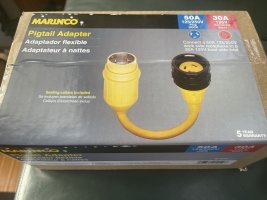Shankara
Member II
Hello all,
I have my eye on a better spot on the dock in my marina, although the power pedestal is 50 A/250 V, and my boat’s electrical system is 30 A/125 V.
I purchased a Marinco pigtail adapter, 50 A 125/250 V plug at Dock - to 30 A 125 V connector to Boat.
Does anyone know if this adapter is ok to use for my shore power hookup? My worry is that my lack of knowledge may case damage to my battery charger or something else.
Thanks,
Shankara

I have my eye on a better spot on the dock in my marina, although the power pedestal is 50 A/250 V, and my boat’s electrical system is 30 A/125 V.
I purchased a Marinco pigtail adapter, 50 A 125/250 V plug at Dock - to 30 A 125 V connector to Boat.
Does anyone know if this adapter is ok to use for my shore power hookup? My worry is that my lack of knowledge may case damage to my battery charger or something else.
Thanks,
Shankara

